If you start searching treks in Nepal the one that probably jumps out at you is the Annapurna circuit trek. This is one of the most popular treks in Nepal. And rightly so it has some of the most beautiful scenery in Nepal and can be done in such a way as to suit your time and budget. On the bucket list for hiking enthusiasts from around the word, this trek takes you into the heart of some of the world’s highest mountains! With its diverse climate zones you start off in the sub tropical and trek through freezing peaks and over snow covered passes. Some of the world’s most majestic mountains are found here, including Annapurna III, Annapurna II, Chulu Peak, Gangapurna, Khangsar, Nilgiri North and Dhaulagiri Massif.
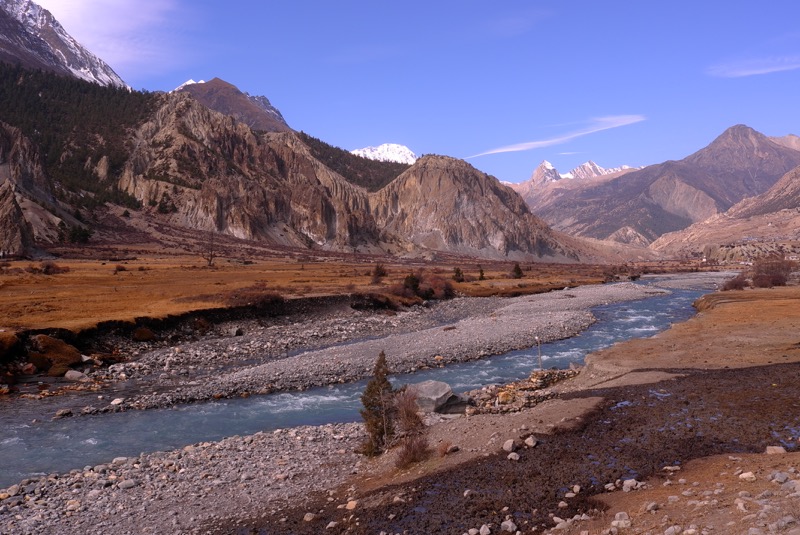
You will trek through both the Manang and Mustang regions of Nepal. Starting in lush farm lands, orchards and pastures you will then come to drier landscapes and, most likely, snow as you cross the Thorong La pass at 5416 m. The people you will meet are mainly Tibetan Buddhist so there is a spiritual atmosphere and good sprinkling of prayer flags, chortens (Structures like cairns) and mani (Prayer) stones. Then interestingly, just after crossing the Thorong La you come across the Hindu pilgrimage site of Muktinath, before entering villages which are again Tibetan Buddhists. Once crossing the large market town of Jomsom, with its tiny airport, the landscape begins to get more green again as the trail head downwards, following the Kali Gandaki River.

With all these different landscapes and climates you need to plan well for this trip. This, like all treks in the Himalayas, is not a walk in the park. It is a serious endeavour but one which will leave you with a thousand great memories and photographs.
Use this guide to get all the information you need about this trek and get planning today!
Getting There
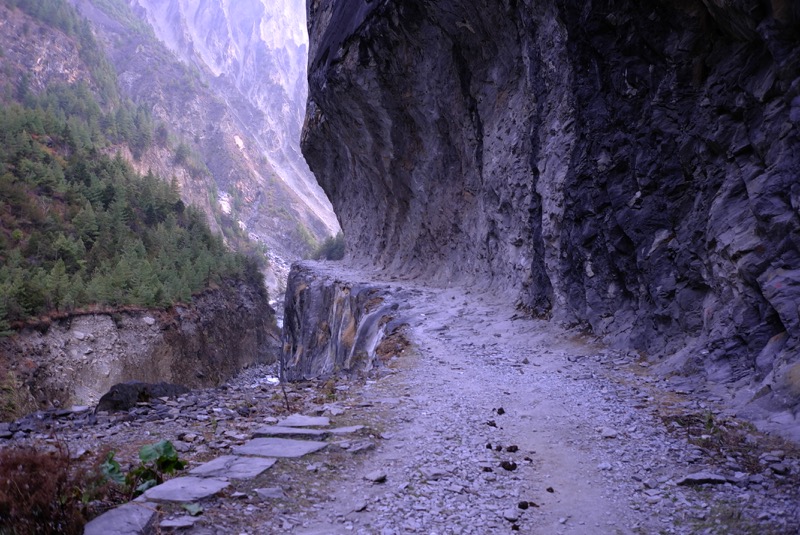
There are no domestic airports in Manang, the starting point for this trek. Well technically there is one in Humde but there are no scheduled flights. There is also no tourist bus to this area. What does that leave? Local bus, local jeep or private jeep are your only options.
Kathmandu To Dharapani By Local Bus
The bus leaves every day from Gongabu bus station to Beshisahar. The bus leaves Kathmandu approximately every 30 minutes until 2 pm. From Beshisahar you will have to get a local jeep as this is as far as buses go. It’s relatively easy to get a jeep but they will wait until they have a full load (very full!) before leaving. Make sure you are there before 2 pm to get a jeep, or overnight and get one in the morning.
It will take you 5 to 6 hours to reach Beshisahar from Kathmandu so it might be pushing it to get there before 2 pm! Then it’s another 4 or 5 hours from Beshisahar to Dharapani. But if you get up early, it is possible to do the whole journey in one day.
The total cost for this journey will be around USD 30.
Kathmandu To Dharapani By Private Jeep
If you go for this option you won’t have to get up so early to head to the bus park in Kathmandu! The jeep can come to your hotel while you enjoy breakfast. Naturally the cost to the jeep is higher around USD300 to 350. But you can fit around 7 people in there, which brings the cost down if you are a small group. It will take approximately 10 hours to complete the whole journey, Kathmandu to Dharapani by private jeep. And you get to stop anywhere on route to get photos and snacks!
Trekking Permit For The Annapurna Circuit Trek
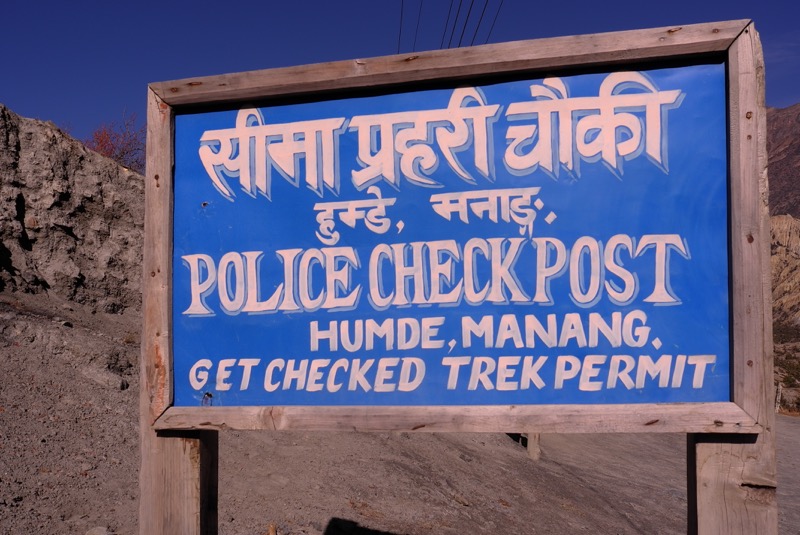
Like all treks in Nepal you will require permits to trek to Annapurna Circuit. These are a TIMS Card at USD 20 per person and the Annapurna Conservation Area Project Permit at USD 30 per person.
With these permits you can also go on to the do the Ghorepani Poon Hill or Annapurna Base Camp Trek as there is no time limited on the permits. They are, however, valid for only one entry into the region.
Note: If you are heading to Upper Mustang (North of Kagbeni) and or the Nar Phu Valley you will need other permits for that region.
If you are trekking through an agency, then they will arrange your permits for you. Simply provide them with two photographs.
If you are doing the trek independently you will need to obtain your own permits. In Kathmandu you get the permits at the NTNC Office at the Nepal Tourism Board on Exhibition Road (15 minutes walk from Thamel). In Pokhara you get the permits at the NTNC Office at Dam Side (30 – 40 minutes walk from Lakeside). Ask for the form, complete, hand over your money and four (4) photographs!
Here is the info made simple below:
Annapurna Conservation Area Project (ACAP) Permit
- The permit cost for ACAP is the same for independent trekkers and for those on an organized trek USD 30.
- For those travelling independently, two photos are required and you need to go yourself (No, you can’t get your friend’s permit) to the office.
- For those trekking through an agency, the agency will get the permit for you, and needs only one photo.
Trekkers Information Management System (TIMS) Card
- TIMS costs USD 20 per person for those trekking alone.
- Two photos are required and you also need to go yourself to the Nepal Tourism Board office in Exhibition Road, Kathmandu.
- TIMS costs USD 10 for those trekking through an agency.
- One photograph is required and the agency will collect the TIMS for you.
Should You Go With Or Without A Guide?

Unlike some of the more remote areas of Nepal, there is no restriction on trekking independently. Every year around 35000 trekkers head to the Annapurna Circuit and most of them are doing this trip independently of an agency. However, I stress you should always hire a guide or a porter on ANY trek in Nepal. This is for your own safety. Let me elaborate on this.
Naturally if you are trekking alone, you will have a good map and have done a lot of pre trip planning. The majority of trekkers have a wonderful and safe trek, but every year we do see accidents happen and people go missing. Which is why I say you should at least take your own guide and or porter.
Pros of having a guide
It can be more fun than trekking alone. There will be someone to have a laugh with and point out things you might miss on the way. He will be able to give you encouragement at the times when the trail might be a little tricky or you are simply too tired to motivate yourself. And if you are injured he will be there to arrange help.
Naturally he will be able to provide you with information! On the route of course but also on village life, the names of mountains, if any local festivals are happening nearby, etc. And he can pre book your accommodation in the busy season! Sometimes teahouses are full so he can help look for an alternative and will know which are the best ones to head for!
If you decide a guide is not needed, a porter will provide some of the above support. Plus carry your bag! Most likely his knowledge of the mountains will not be as extensive as a guide’s, but he will know the trails and be there to help should you need it.
By hiring either a guide or porter you also support the local economy. Something worth thinking about.
Cons of having a guide
Do research before buying into a package deal. The prices vary considerably! So it’s cheaper to go it alone.
You will be more flexible on your own, free to spend your time exactly as you want and free to choose where you eat and sleep. Guides have favourite spots and guesthouses. If you are on your own you can chose where you want to stay. Keeping in mind accommodation is scares during peak trekking seasons!
When is the Best Time to do the Annapurna Circuit Trek?

In a nutshell it’s best to trek the Annapurna Circuit from mid September till mid December and then from end of March to end of May. BUT, since this trek has such a wide variation in elevation and climate zones you need to try (Which will be difficult) to balance weather, the views, and other factors.
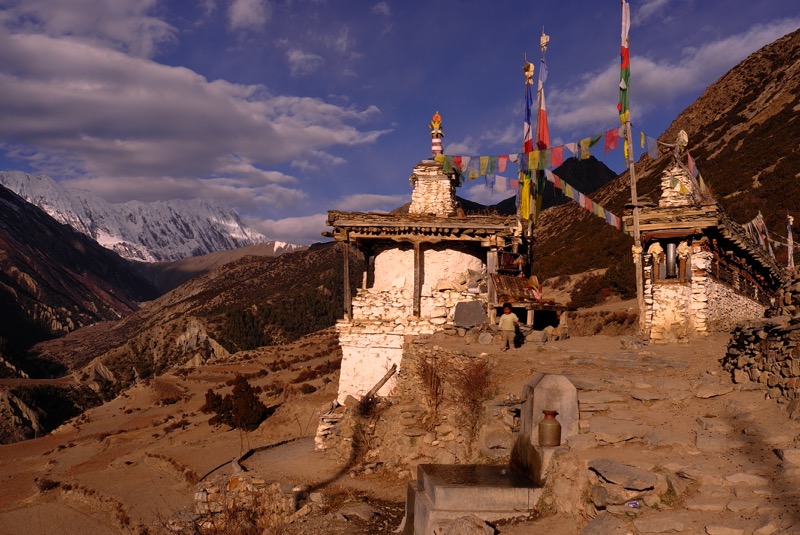
For example you start this trek at 1900 m which will be warm, maybe even hot. You reach as high as 5416 m at the Thorong La pass, which will obviously be cold! And probably have snow. So basically in your 12 days or so you are coming across all the seasons of the year!
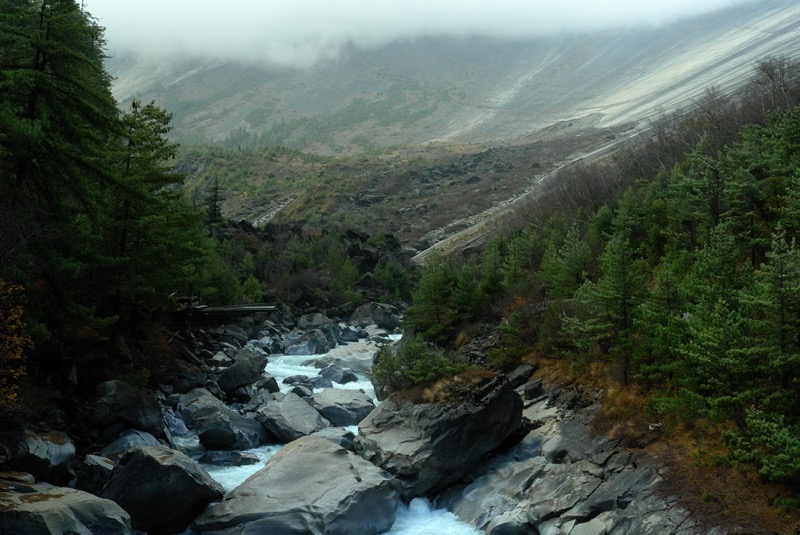
As this region lies in the rain shadow of the Annapurna you can trek in the monsoon. But just be prepared for rain and mud! But certainly not a lot of people and not the best mountain views. However, having the place to yourself and a good choice of lodges may make up for this. But if you are going in the monsoon, build in extra time if you are thinking to fly out of Jomson, as flights may be delayed. The road may also be out due to landslides. But it would be an adventure.

In the winter there will be risk of blocked passes and avalanches. Definitely anywhere over 4000 m is going to receive heavy snow. I do not recommend trekking here in the winter.
But if you like cold there is an ice climbing festival held in Manang in the early spring. Check it out here.
Also, it is important to pack for your trip wisely. Charlotte from Charlotteplansatrip share her Himalayan trekking pack list. Do check it out.
Annapurna Circuit Trek Map

The Annapurna Circuit has options on where to start and where to end. So for this reason alone, a map will be vital to planning your trip. While on the trek you will need a printed map. But in the meantime this Annapurna Circuit Trek Online Map covers almost every trekking route in the Annapurna region with the exception of the Upper Mustang Trek Map and will certainly be a great help to plan your trip.
Annapurna Circuit Trek Itinerary
In the past the Annapurna Circuit Trek would take you 20 to 24 days! But now since there is a road connection at both ends of the trek, it can take you only 12 days. More if you want to add on some side treks.

As mentioned, you can start this trek at different places. The starting point that I recommend is Dharapani. Dharapani is also the ending point of the Manaslu Circuit Trek and at only 1900 m is the ideal elevation to start your trek in terms of acclimatization. The road does go on further than Dharapani, but for acclimatization reasons, I suggest you don’t drive further up the trail but start here.

Once you have crossed the Thorong La pass, crossing from Manang to Mustang, you can hike for a day, drive for a couple of hours, or, more interestingly, stay overnight at the small walled village of Kagbeni, on the way to Jomson. At Jomson you can fly out to Pokhara. The alternative is to trek on down to Tatopani at Beni and drive to Pokhara. It is also well worth the time to – from Tatopani – head to Ghorepani Poon Hill for its stunning sunrise views across the Annapurna. From here you can then walk down to Ulleri or Naya Pool and drive to Pokhara.
Here is my recommended itinerary:
[table id=21 /]
Food And Accommodation On The Annapurna Circuit Trek

Apart from at the higher elevations, the accommodation is pretty good on this popular trek. With the roads came also some more luxurious lodges in places like Manang, Muktinath, Kagbeni and Jomson. But these come at a price! Check them out before you go. In general most of the lodges have twin rooms (A room with two beds) and either private or shared bathrooms depending on the location and your budget. Since you will be wearing plenty of clothes to bed, and not showering every day, a shared bathroom is not so much of a hardship.

As for food, most of the lodges have good food. Remember that the unwritten law is that you eat where you sleep! To enforce that, the lodges all have the same menu! Dal bhat is available everywhere and comes with unlimited refills! Western and Nepali food is available such as pasta, momo, soups and some meat options. If you are travelling in a group, it’s probably best to compromise and all order the same thing. This speeds up the process in the kitchen and you get your meal more quickly. Something worth considering in the busy season!

As a plus, and don’t forget to look for it when you get there, Himalayan Java in Jomson serves fantastic coffee.
Drinking water
In this area mineral water is banned in order to reduce the number of plastic bottles which are left along the trails. So do remember to bring your own sterilizing method (Drops, tablets, filters) or buy safe drinking water from the teahouses. You can collect tap water for free (but DO sterilize) or pay for safe drinking water.
How Much Does It Cost To Trek The Annapurna Circuit?
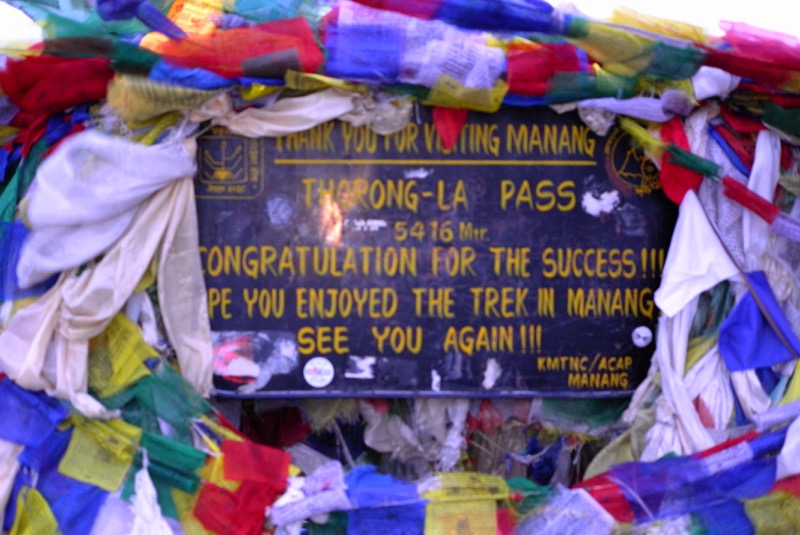
If you decide to go on an organized trek it could cost you from USD 700 to USD 2000.
Should you decide to go independently, it will cost you considerably less. In fact for a 14 day trip from Kathmandu to Kathmandu it could cost you as little as USD 530. Breakdown as below:
Permits USD 50
Local transport USD 50 to 60 (Kathmandu to Kathmandu)
Food and accommodation @ USD 30 per day
Optional costs:
A local guide USD 25 to 40 per day
A local porter USD 18 to 22 per day
But do remember to carry extra cash for contingencies, emergencies and that extra bottle of beer!
